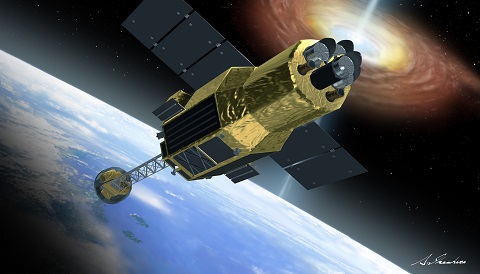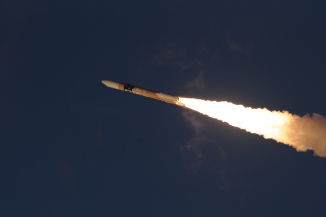| Update (April 28, 2016): The Japanese space agency JAXA has just announced that they will end recovery attempts for the Hitomi satellite. Observations show that the solar panels were flung off during the spacecraft's too-fast rotation, depriving Hitomi of power and ending the mission. Read more: JAXA's release. |
| Update (April 19, 2016): Current observations show that Hitomi is spinning around once every 5.2 seconds, a rotation speed JAXA considers to be "very fast." The Hitomi team has proposed that an anomaly in the attitude control system might have caused the spacecraft's high rotation speed, which then might have caused vulnerable pieces (such as Extension Optical Bench or the solar cell panels) to separate from the main body of the satellite. However, the cause of the attitude control system's failure continues to be under investigation, and JAXA is still trying to re-establish consistent communications with the satellite. Read more in JAXA's newest press release and receive additional updates as they're available at JAXA's website |

JAXA
A new flagship observatory developed problems this weekend, as the Japanese Aerospace Exploration Agency's Hitomi X-ray observatory experienced what engineers are terming a "communications anomaly" over the weekend.
Following its launch on February 17, 2016, from Tanegashima, Japan, the Astro-H astronomy mission was renamed Hitomi ("pupil of the eye" in Japanese). All was well as the spacecraft reached orbit. Hitomi passed initial checkouts with flying colors, extended the boom housing its optical bench, and completed its critical checkout phase on February 29th.
The Current Situation

JAXA
Trouble struck this past weekend on Saturday, 7:40 Universal Time, when Hitomi failed to "phone home" during a routine ground station pass. At the time, Hitomi was cooling down its sensitive instruments as part of its initial three-month checkout, in preparation for full-scale observations. After the initial anomaly, the satellite responded briefly once more before falling silent.
At this point, little more is known. On Sunday March 28, the U.S. Joint Space Operations Center (JSpOC) issued more bad news, as it tracked five additional pieces of debris related to Hitomi. However, the size of the debris is not yet known.
Speculators say Hitomi may have been involved in a debris-generating event such as a collision or (more likely) the rupture of an onboard tank. JSpOC also noted on Twitter Sunday that another debris event over the weekend is not related. Hitomi's orbital perigee has also decreased by about 5 kilometers in the past 48 hours, which would also be in line with a possible propulsive event.
Backyard satellite watchers are also scrambling to get a good look at Hitomi as well. There has been a lively discussion on the SeeSat-L message board, and observers Ron Lee and Paul Maley based in the southwestern United States say Hitomi is tumbling once every five seconds.
However, while the Japan Aerospace Exploration Agency (JAXA) has confirmed that the spacecraft broke into multiple pieces, they added that the last signal they received came after the break up. JAXA has set up an emergency action team that's working hard to recover the spacecraft.
The Future of Hitomi
Hitomi is in a very similar orbit to Hubble, inclined at 31 degrees to the equator and visible from 40 degrees north to 40 degrees south latitude. You can watch for visible passes of Hitomi/Astro-H for yourself using Heavens-Above. The satellite is listed under Heavens-Above's 'satellite database' as NORAD ID 41337, designation 2016-012A.

Orbitron
The Hitomi mission includes scientists and engineers from 61 nations, including NASA scientists involved in the Soft X-ray Spectrometer instrument onboard the spacecraft. Hitomi holds great promise, as it has the versatility to observe astronomical targets simultaneously across the low- and high-energy X-ray spectrum. It carries on the legacy and even surpasses some capabilities of other orbiting X-ray observatories such as NuSTAR and Chandra.
We're not ready to write Hitomi off just yet, though the news certainly isn't good. If there's any silver lining, this event appears more like Hitomi shedding debris, rather than Hitomi strewn in pieces. Controllers may yet be able to salvage the spacecraft and the mission.
Watch for more updates as they become available.
 4
4









Comments
April 1, 2016 at 6:41 pm
Sorry to burst your bubble but the satellite can't be shedding "debris". They don't launch satellites with some extraneous garbage going along for the ride. That's Star Wars fiction. The debris that you're referring to is the satellite itself breaking up into smaller pieces. And those pieces were all critical components. There is no silver lining in that. Sorry, but this satellite is almost certainly a total loss. Sad.
You must be logged in to post a comment.
David DickinsonPost Author
April 2, 2016 at 4:18 am
Correct; things certainly don't look good for Hitomi at this point; however, as noted, there's a big difference between 'pieces shedding from Hitomi,' and, as many news outlets have reported, 'Hitomi breaking up into pieces.' Sort of like a bolt falling off your car, vs the engine falling out. But yes, the very fact its in a 5 second spin (we saw as much during a pass over southern Spain last night) isn't good.
You must be logged in to post a comment.
April 2, 2016 at 9:38 am
If the US military radar is able to find five pieces near Hitomi, those pieces are not bolts or other small items. At the least, they are tracking outer panels that have been blown off. Indicating a large explosive event. Or worse, the satellite exploded and has indeed structurally broken up. Either way, the analogy of "a bolt falling off your car" is an underestimation of the situation. More like the hood and all the doors came off of the car. And in space flight, if all the doors fell off you have a major problem and 'debris' isn't exactly the right word for it. But lets not argue semantics over the likely imminent death of such a valuable scientific satellite. It's still a terrible loss.
You must be logged in to post a comment.
David DickinsonPost Author
April 2, 2016 at 12:49 pm
Actually, make it ten pieces of debris and counting now, as per JSpOC today: https://twitter.com/JointSpaceOps/status/715925669494923266
You must be logged in to post a comment.
You must be logged in to post a comment.